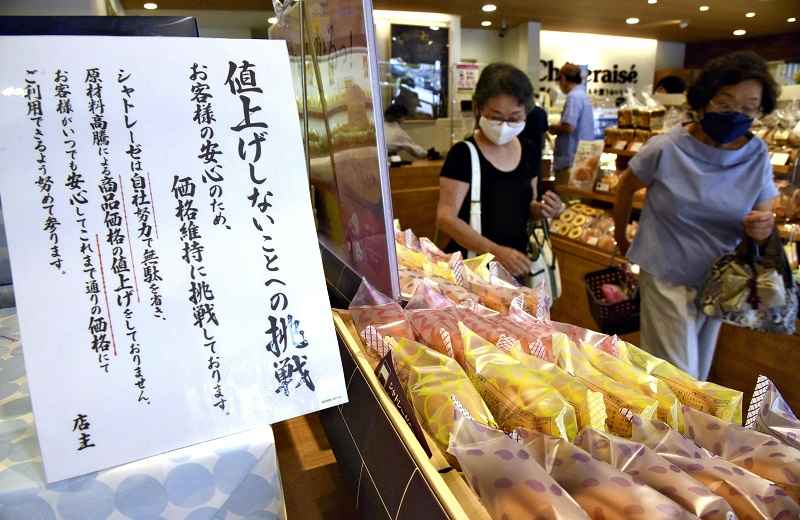Restaurants, food companies try to hold prices steady even as costs rise

At a Chateraise store in Aoba Ward, Yokohama, a board has been set up informing customers that the store intends to keep prices unchanged.
10:41 JST, August 9, 2022
In the midst of a rush to hike prices as the costs of raw materials and transportation soar, some restaurant chains and food manufacturers are trying to maintain or even lower the prices of their products, in the hope of expanding the number of stores and increasing sales by giving customers a sense of value.
Employees offer ideas
“The challenge to not raise prices.” At a store of the Chateraise confectionery chain in Sakuradai, Aoba Ward, Yokohama, several signs inform customers that the store intends to keep the prices of its products unchanged, at least in this fiscal year. For example, custard puddings and cream puffs will remain ¥108 each including tax.
The cost of wheat flour, a raw material for confectionery, has risen by about 20% since last year, while the prices of fats and oils have gone up about 50%. Given the situation, the chain introduced a program in January in which employees are asked to suggest cost-cutting ideas, and they are rewarded according to their contribution. As many as 500 proposals a month have been received, according to the company.
By July, the operator had cut costs by more than ¥400 million a year by, for instance, replacing plastic cake trays with paper ones, thus trimming the cost by about ¥8.5 million a year. These efforts have enabled the operator to maintain product prices.
Family restaurant chain operator Saizeriya Co. did not change the prices of its standard menu items in its menu renewal last month. As the operator expects to reduce the cost of utilities by installing solar panels at its factory next year, it has concluded that “there will be no need to raise prices.”
Issei Horino, president of Saizeriya, said, “We would like to absorb the deterioration in profit through various improvement measures.”
Raising efficiency
Mos Food Services, Inc., which operates hamburger chain Mos Burger, has kept the price of the White Mos Burger at ¥790 if ordered in a set, which includes a soft drink and an “edamame corn fry” side dish. This is up to ¥260 cheaper than when the same menu items are ordered separately.
“By selling them in sets, we get the benefit of economies of scale when buying foodstuffs,” said Yoshinori Ando, a senior executive officer at Mos Food Services.
Next Meats Co., a venture firm that deals with plant-based meats, such as those made from soybeans, as alternatives to pork and the like, cut the wholesale prices of its products by about 30% in April.
When the company started in 2020, it used small-lot production. But by increasing its output, it raised production efficiency and was able to realize price cuts. “Now is an opportune time when the price of meat is rising,” said an official in charge of public relations.
In the face of these moves, an official at one leading food maker said, “Our rival firms making do without raising prices through their corporate efforts would make it difficult for us to raise prices.” Another official at a leading confectionery store chain that has been raising its prices said, “We would be very troubled if such price-cutting moves were taken [by our rivals] one after another.”
While the pressure to hike prices is growing, corporate efforts to better deal with it are likely to continue in the days ahead.






